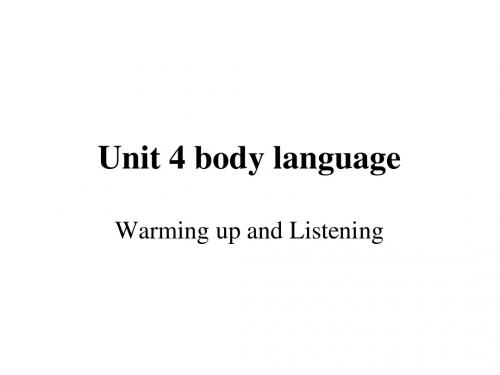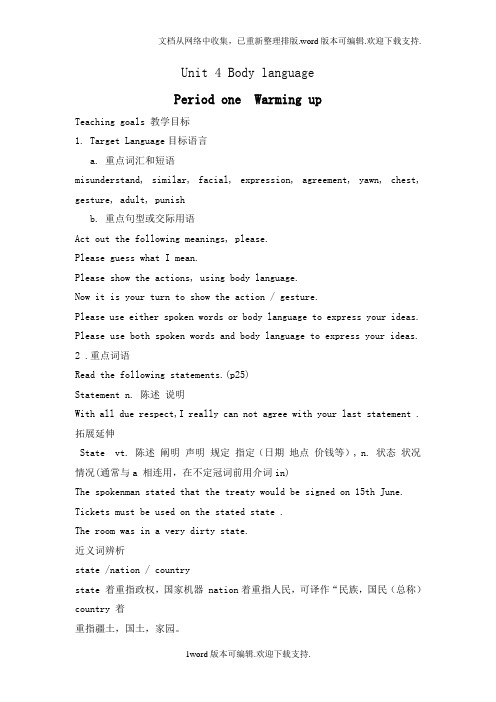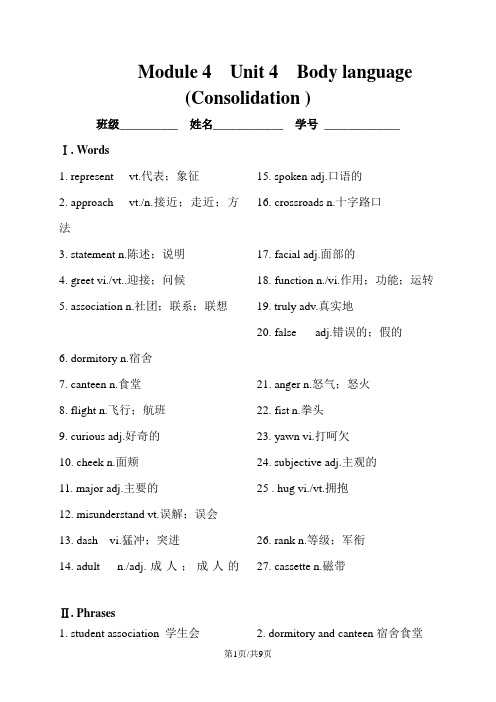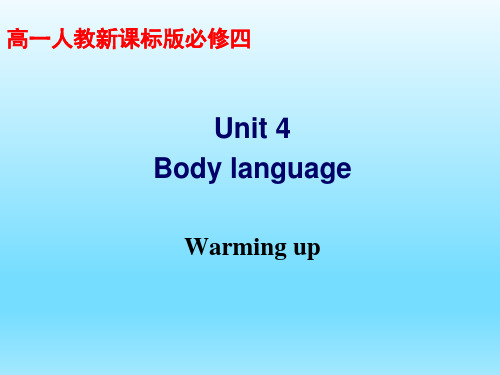高一英语Module4 unit4 Body Language
- 格式:doc
- 大小:135.50 KB
- 文档页数:24

人教版高一必修四Unit 4 Body languageUnit 4 Body language---Warming up and Reading教学重点:1. Let students read the passage and learn about culture differences and intercultural communication.2. Get students to learn different reading skills, especially the reading ability of understanding implied meaning of the author.教学难点:1. Enable students to understanding the passage and know about cultural differences and intercultural communication.2. Let students learn how to use different reading skills for different reading purposes.教学目标:1. Develop students’ reading ability and let them learn different reading skills.2. Help students know about cultural differences and different cultural body language.教学过程:Step 1 Leading in and warming up (5 minutes)1. Show some pictures on the screen and have a free talk with students about what the person in the pictures is communicating.2. Show the pictures about body language on the screen. Let students guess their meaning. Step 2 Reading (20 minutes)1. SimmingWhat is the main idea of the text?A. There are different customs in differentcountries.B. Foreigners should follow the customs ofthe country where they are visiting.C. People use body language to sendmessages and people from differentcountries have different customs.D. The importance of knowing customs.2. ScanningWhile reading, please try to divide the whole passage into four parts and match the main idea.3. Intensive readingAllow students to read the passage carefully this time to get the important details, and then finish the following: (show the following on the screen)Step 3 Writing (15 minutes)When in Rome, do as Romans do.(入乡随俗)Your best friend Li Lei is going to travel abroad, please write a letter to tell him some tips about the different greeting ways in those foreign countries.•Travel around the world↙Jordan←France↖China Britain↘Japan →Colombia↗Dear Li Lei,I’m so excited to hear that you are going to travel abroad. And I'd like to tell you something about the greeting ways.In Japan, people prefer to …People in Colombia like… English people do not usually…The Fr ench custom is … Men from Jordan will often……Wish you a good journey!Yours,…Step 4 Homework1. Finish the letter after class.2. Find more information about body language in different countries.本节课教学反思:本节课的课件设计比较符合我班学生的实际情况,课堂气氛也挺好,学生比较积极活跃。


Unit 4 Body languagePeriod one Warming upTeaching goals 教学目标1. Target Language目标语言a. 重点词汇和短语misunderstand, similar, facial, expression, agreement, yawn, chest, gesture, adult, punishb. 重点句型或交际用语Act out the following meanings, please.Please guess what I mean.Please show the actions, using body language.Now it is your turn to show the action / gesture.Please use either spoken words or body language to express your ideas. Please use both spoken words and body language to express your ideas.2 .重点词语Read the following statements.(p25)Statement n. 陈述说明With all due respect,I really can not agree with your last statement . 拓展延伸State vt. 陈述阐明声明规定指定(日期地点价钱等), n. 状态状况情况(通常与a 相连用,在不定冠词前用介词in)The spokenman stated that the treaty would be signed on 15th June. Tickets must be used on the stated state .The room was in a very dirty state.近义词辨析state /nation / countrystate 着重指政权,国家机器 nation着重指人民,可译作“民族,国民(总称)country 着重指疆土,国土,家园。

Module 4 Unit 4 Body language(Consolidation )班级__________ 姓名____________ 学号_____________ Ⅰ. Words1. represent vt.代表;象征2. approach vt./n.接近;走近;方法3. statement n.陈述;说明4. greet vi./vt..迎接;问候5. association n.社团;联系;联想6. dormitory n.宿舍7. canteen n.食堂8. flight n.飞行;航班9. curious adj.好奇的10. cheek n.面颊11. major adj.主要的12. misunderstand vt.误解;误会13. dash vi.猛冲;突进14. adult n./adj.成人;成人的15. spoken adj.口语的16. crossroads n.十字路口17. facial adj.面部的18. function n./vi.作用;功能;运转19. truly adv.真实地20. false adj.错误的;假的21. anger n.怒气;怒火22. fist n.拳头23. yawn vi.打呵欠24. subjective adj.主观的25 . hug vi./vt.拥抱26. rank n.等级;军衔27. cassette n.磁带Ⅱ. Phrases1. student association 学生会2. dormitory and canteen宿舍食堂3. greet sb 问候某人4. body language身势语5. introduce sb/sth to sb 向某人介绍某人/物7. kiss sb on the cheek亲某人脸颊8. in defence/ defend against 自卫9. a major misunderstanding 大的误会10. shake one’s hand 摇头11. on the contrary相反的12. Muslim countries 穆斯林国家14. express one’s feeling表达一个人的情感15. be likely to do很可能做……16. in general 总的说来17. a world of cultural crossroads文化交融的世界18. physical distance, action or posture身体距离,动作和姿势20. facial expression面部表情21. at ease安逸;自由自在23. lose face丢脸24. turn one’s back to背对着;背弃Ⅲ. Sentences1.如果有必要, 我们可以更改旅行日期。


高中英语教学设计教学重难点Teaching FocusMake the students understand that body language has cultural diversity and there is no division of good or bad for the diversity.ChallengeMake sure that the students will have the awareness to use and try to understand others’ body language when they communicate with others in the future.教学准备A. A projectorB. computer for multimedia teaching教学方法Teaching methodsA. Asking-and-answering between the teacher and the studentsB.. Interaction among individuals, pair-work and group-workC. Task-based teachingD. Teacher’s demonstration and interpretationE. Role-playingF. Students’ discovery教学过程设计活动内容Step 2介绍身势语的重要性A.Telling Students the Story of Tai Lihua and Making Them Know theImportance of Body Language in Her Life ( 3 min )1.Present the pictures of Thousands of Hands Kwan-yin , and ask the students whether they know thegirl who dances in the front.2. Tell the students tell life story of Tai Lihua and ask them the question “What are the key factors forher success in her life?”The life story of Tai LihuaHer name is Tai Lihua(邰丽华). She is called a Fairy of Peach blossom(桃花仙子) by people. You knowshe is a deaf girl, but she is a wise, diligent, charming and energetic girl. She studied very hard and got two degrees of bachelors in university. She was famous as an artist for her wonderful performance. She is deafand dumb. But how did she get that great achievement and became a successful person? She loves life very much. We should learn from her spirit. Besides her hard working, body language plays a very importantpart in her life. We are all healthy people, sometimes we can use body language to express ourselves. Sowe should pay more attention to learning body languages.B.Showing the Students the Science Report of the Importance Body Language,Making Them Know That Body Language Is As Important For Us As ForDisabled Person Like Tai Lihua. ( 1 min )Some psychologist believe that we communicate 65% of our ideas and feelings without words! The shape of our bodies and faces, the movements and gestures we make, the clothes we wear, how near we stand to each other and whether we touch each other…all these communicate. we must study all these types of information if we want to truly understand what other people are saying.Step 3介绍不同类型的身势语() ( step 3 will use around 5 min )A. Showing the Students The Four Types of Body LanguageGestureFacial expressionEye contactPostureB. Guessing The Meaning of GesturesThe teacher show the students a series of pictures of a man using different gestures, and the students are supposed to say their meaning.C.Acting Out By GesturesThe teacher show the students some English words and ask them to act them out together by using gestures.Victory!Ok !Be quiet!D. Chasing the Right WordThe teacher will show the students a series of pictures describing different facial expressions and askthe students to choose the right word for each.E. Matching the Right Interpretation Of the EyesThe teacher will present students several pictures of eyes and ask the students to match the right interpretation.You!Threatening No. sixThank you ! Congratulations!Facial expressionanger fear joy sorrow contempt轻视surprise disgust 厌恶What do you see in the eyes below?That’s a problem. I need to thinkfor while.a whileIt’s you! Let’s have a duel!That’s horrible! I’m terrified!The next minute,you’re a dead body!I’m in great sor rowness…I won’t give up! We’ll soon winback!F. Guessing The Meaning of Postures in Real ContextI give up!OK!You are asking help from this woman…You are saying “Will you give up!”…Give me a little time!I’m still thinking!You are asking this womanTo finish her work as soon as possible…You are asking this woman ”Have you got any good idea?” …I’m listening carefully!What do we know from their posture?Nice to meet you!This woman is listening to your ideas…You meet this man for the first time…G. Matching the Right Meaning of the Given Posturesnervous Bite your nails and fondle hair agreement Nod the head up and downBe not interested Look away or yawn.Do not believe Roll your eyes and turn your head away. angry Frown and turn your back to sb disagreement Shake the headStep 4给身势语下定义A.Finishing the First Question of Warming-up Part ( 3 min )The teacher will ask the students to discuss the question with your partner and try to find what the people in the pictures are communicating.B.Giving Definition To Body Language ( 2 min )The teacher will guide the students to give a general definition to body language.Body languageis a form of non-verbal communication.uses movements or positions of our body to show other people what we are thinking or feeling.mainly includes gesture, facial expression, eye contact, posture four forms.Step 5练习运用身势语A.Acting Out the Following words ( 4 min )This exercise is based on the second question of warming-up part. Two students will be chose to the frontof the class, and each of them will choose five words to act. After their action, other students will try to guess which word they have acted.•Hello!•Goodbye!•Go away!•Expensive!•I’m surprised!•I’m tired•I’m confused!•Good luck•I’m delighted!•I’m upset!•I’m sad!•I forgot!•You are great!•I’m curious!•I ate too much!•Come here!B.Acting Out the Dialogue on Page 67 ( 10 min )The student will work in groups of two to finish the speaking task of this unit on page 67. They are required to use appropriate body language as they are making dialogues. After their pairwork, volunteerswill make their dialogue before the whole class.Step 6介绍身势语的文化多样性A.Showing the Cultural Difference in Body Language With Examples ( 2 min )America OKJapan moneyFrance zeroBrazilGermanyrudeB . Presenting the Students the Major Greeting Customs in the World ( 2 min )Person and country Suitable greeting A man from ColumbiaTo a man: same as for a womanTo a woman: touches her shoulder and kissesher on the cheekA woman from BritainTo a man: not to close, shake hands To a woman: shake hands, will get closeA man from JapanTo a man: bowsTo a woman: bowsA man from CanadaTo a man: shake handsTo a woman: shake hands or kisses on both cheeks if knownA woman from FranceTo a man: shake hands, kisses twice on the cheekTo a woman: same to someone she knowsA man from the Middle East or some Muslim countriesTo a man:comes close, shakes handsTo a woman:nodsC. Discussion On the Question That If There is a Division of Good or Bad of the Different Meaning of The Same Body Language Under Different Culture.The students will have 3 minutes for discussion and after that some of them will represent their group to share their idea with the whole class.USA Nigeria rude Germany Japanone“great”or “good job”。
Unit 4 Body languageTeaching aims:1.TopicBody language; cultural differences and intercultural communicationeful words and expressions:Nouns: check, stranger, action, comedy, expression, agreement, chest, gesture, adultVerbs: approach, represent, introduce, touch, express, nod, avoid, misunderstanding, yawn, punish Adjectives: major, local, curious, spoken, general, similar, facialExpressions: be likely to, at ease3.Functional items:1. Prohibition and warningsDo not smoke here.Watch out! A car is coming!You may not….Don’t slip.Always stay….Be careful when…Don’t enter here.Don’t sit here.Stop!Be quiet.2. ObligationYou /He must…You should never…4.Grammar1). The –ing form as the attribute.They are visitors coming from several countries.… and this is an exciting experience for you…His nose touches Mr. Cook’s moving hand….2). The –ing form as the attributeFour people enter looking around in a curious way.She arrives hurrying, recognizes Mr. Garcia’s smiling face…Teaching proceduresPeriod 1 SpeakingStep 1. Warming-upT shows some pictures on screen. These pictures are from the Evening Party Celebrating the coming Lunar New Year ofthe Rooster of 2005.Step 2. SpeakingTask 1.Ss look at the screen and try to explain the meaning of the pictures.Suggested answers:Task 2. Ss finish warming up on page 25.Suggested answers:Time forfunTask 3.Ss ingroups offour. Onethinks ofasituation and asks the others to show some actions using bodylanguage. When the one chooses the action that is most likely,it is his or her turn to think of some other situation forthe others to show the actions so that the game may go on fora few rounds.Step 4. TalkingTask 4. Get the Ss to work in pairs. The situation is thatyou are worried about Lin Pei, who is not friendly any more,and does not want to talk to you or her other friends. Sheseems to be sad. She stays alone. She is not doing her homeworkand the teacher is not pleased with her. She doesn’t seemto care about how she looks and behaves.Step 5. Role playTask 5. Ss finish the speaking task on page 67.Period 2. ReadingStep 1. Warming upTask 1. Ss try to answer the following questions:1.What is the purpose of language?2.Do people send each other messages only by words? Whatother ways can be used?3.How can you tell if someone is sad even if they do notspeak?4.Give an example of how you can communicate a feeling tosomeone who does not speak your language.Step 2. ReadingTask 2: Ss read and answer the following questions:1.What’s the main idea of the passage?2.How many parts can the passage be divided into?3.What’s the main idea of each part?4.What can we learn from the passage?A.Never too old to learn.B.Do as the Romans do.C.Four eyes see more than two.D.Every country has its own customs.5.“Mr Garcia approaches Ms Smith,…” the underlined wordhas the same meaning as __________.A.all the approaches to the palace were guarded bytroops(军队).B.The club has made an approach to a local business firmfor sponsorship(资助).C.The time is approaching when we must think about buyinga new house.D.I find him difficult to approach.Task 3: Ss read and fill the following chart:Step 4. After- readingTask 4: Ss in groups and discuss:Suppose your friend is to attend an English corner. Many students coming from different countries will be present as well. She is excited but nervous because she doesn’t know how to make others accept her. What should she do then? Period nguage learningStep 1. RevisionSs retell the text with their own words.Text retelling:My boss has sent me to Pudong Airport to meet some business people from many parts of the world, who are interested in the development of the economy in China.The first one to arrive is Mr. Garcia from Columbia with Julia Smith, a British lady, following behind closely. I introduce them to each other and I’m surprised to see Mr. Garcia come up to Ms. Smith, touch her shoulder and kiss her on the cheek while Ms. Smith steps back appearing surprised. Just then, in comes a visitor from Japan, smiling at the time when the Canadian, George Cook reaches out his hand to him. It happens that Mr. Cook’s hand touches the Japanese’s nose as he bows and they both apologize.So you see, people from different cultures may not greet others in the same way. English people usually do not stand very close to others or touch strangers as people from Spain, Italy and South American countries do. Most people around the world shake hands when they meet while Japanese people will bow. People from Jordan stand quite close to other men and shake hands, but they simply nod to women. And French people shake hands and kiss others on the cheeks.In a word, body language varies in different cultures and is widely used in communication.Step 2. The –ing form as the Attribute and AdverbialAsk Ss to pick out the sentences with v-ing in them and underline them:1.They are visitors coming from several other countries…2.Four people enter looking around in a curious way.3.This is an exciting experience for you, so you standwatching and listening.4.You see her step back appearing surprised, and take a fewsteps away from Mr. Garcia.5.The visitor from Japan comes in smiling at the same timeas George Cook from Canada.6.His nose touches Mr. Cook’s moving hand, and they bothapologize.7.…, nor are they comfortable touching strangers or beingtoo close or too far away.8.…, they also express their feelings using unspokenlanguage through keeping physical distance, actions or posture.9.Most people around the world now greeting each other byshaking hands…10.She arrives hurrying, recognizes Mr. Garcia’s smilingface, and then they shake hands…11.It is an interesting study and can help you avoiddifficulty in communication.12.In most countries, nodding the head up and down showsagreement, while shaking the head means that you do not agree…13.If you stand holding your arms across your chest, you maybe protecting yourself…14.If you sit looking at and turn toward the person you aretalking to…15.We show respect for people by using different gestures.16.Children are taught that looking directly at an adult isnot good behavior.17.…so it is an amazing thing that we understand each otheras well as we do.18.Showing our hands means that we are not armed.19...the Western custom of shaking hands is used,20.Japanese people might cover one hand with the other and,depending on whom they are greeting, how slightly or quite low.Step 3. Language points1. make: make sb do sth.Make oneself doneMake sth to doHis father’s death made him leave school.He was made to leave school by his father’s death.I had to speak loud to make myself heard.They had to make a fire to warm themselves.2. prepare: v. preparation: n.prepare for:be prepared to do3. disappoint: v. disappointment: n.disappointed / disappointing: adj.4. closely /closeShe sat close against the wall.Please listen closely.Come close to doing sth.= almost doing sth.5. Not all cultures greet each other the same way, nor are they ….表否定的not放在句首,该句用倒装语序。
⾼中英语必修4Unit4Bodylanguage Unit 4 Body language I.单元教学⽬标II.⽬标语⾔Ⅲ.教材分析和教材重组1.教材分析本单元以Body Language——―体态语‖为中⼼话题,具体涉及什么是―体态语‖,如何理解―体态语‖,以及―体态语‖的跨⽂化性等。
本单元的语⾔技能和语⾔知识也都是围绕―体态语‖这⼀中⼼话题设计的,旨在通过单元教学,⽤听、说、读、写、做(表演)等多种形式,让学⽣正确认识和掌握―体态语‖在交际中的作⽤和意义,使学⽣明确―体态语‖在⼈类交际中的重要性,了解―体态语‖在不同民族、不同⽂化交际中的多样性;使学⽣在今后的⽇常⽣活、学习、⼯作和交往中尽量减少或避免运⽤―体态语‖时可能产⽣的误解,提⾼他们的―语⾔交际‖能⼒和―⾮语⾔交际‖能⼒。
1.1 WARMING UP 以列表对⽐(填充及增补)的形式,并通过WARMING UP 的活动,让学⽣了解有声语⾔与―体态语‖的对应关系,了解语⾔意义与⾏为意义(―体态语‖)在交际中具有同等重要的作⽤。
同时,学⽣在听、说、做(即表演―体态语‖的动作)中能够增进对语⾔交际的感性认识,为他们在阅读过程中上升到对语⾔交际的理性认识打下基础。
1.2 PRE-READING 通过提供三个关于不同⽂化背景下―体态语‖的问题,启发学⽣思考我们所学习的―语⾔‖的⽬的、形式、功能。
通过引导学⽣联系⾃⼰⽇常⽣活的实际,提⾼学⽣努⼒学习英语的积极性和⾃觉性;同时培养学⽣留⼼社会、关注⽣活的洞察⼒,为引导学⽣进⼀步―阅读‖作好准备。
1.3 READING 是⼀篇介绍性(记叙⽂)体裁的⽂章,主要介绍了各种⽂化背景下的―体态语‖的异同,为学⽣提供了来⾃不同国度、不同语⾔⽂化背景的―体态语‖及其在交际中的异同和影响的具体例证。
学⽣也可以结合⾃⼰在语⾔交际中所遇到的实际例⼦来进⼀步理解―交际,毫⽆问题可⾔吗?‖这⼀主题。
1.4 COMPREHENDING 包括⼋个问题(前5个旨在检查学⽣对阅读材料细节的理解,6~7旨在引导学⽣对―体态语‖的意义及⽂化差异的思考,第8个检查学⽣能否通过细节进⾏推理判断),通过对来⾃不同国度、不同语⾔⽂化背景的六个⾓⾊对待男⼥不同性别所使⽤的―体态语‖异同的(学⽣在⽼师指导下的⾃我或⼩组讨论后的)归纳,进⼀步熟悉和掌握―体态语‖在不同语⾔⽂化交际中的作⽤和意义。
高一英语Module4 unit4 Body Language高考解读【高考导航】2010高考命题趋向分析:1.approach为新课标重点单词意思:(1)vt 接近,靠近(2)n 接近,方法;途径。
考点主要是它作为动词的意思及作为名词常与to连用,表示“......的方法”。
06年湖北卷对这一用法进行了考查。
还要注意它与way,method的区别。
此考点在2010年高考命题的侧重点可能放在名词的用法上2. curious是新课标重点单词。
意思为:好奇的。
考点主要是它的两个固定搭配:be curious about对……好奇及be curious to do 极想做某事06年辽宁卷对be curious about进行了考查。
2010年,考生应该重视be curious about的重要用法3.be likely to do为新课标重点短语。
主要考查角度是它的意思及它与be possible to do ,be probable to do的区别,主要是主语的区别,likely的主语既可以是人也可以是物;而possible和probable主语只能是形式主语it.主要考查形式为单项选择及完形填空。
2010年有可能考查它与possible和probable区别上4.lose face为新课标重点短语。
考点主要是它的意思及和lose相关的其他短语,如lose heart 灰心, lose one’s heart to 爱上lose weight减肥, lose one’s way 迷路,lose one’s life 丧生。
其中,08上海卷对lose heart进行了考查。
2010年学生应重点掌握短语的区别。
特别是lose heart【真题品析】(2006.年湖北卷) At tile meeting they discussed three different ______to the study of mathematics.A. approachesB. meansC. methodsD. ways【答案】A 考查名词词义辨析。
approaches方法与to连用,表示……的方法,而means翻译为方式,不可与to连用。
methods 与with 搭配。
Ways则与of连用,和to连用时,to为不定式to,不是介词to.【点拨】注意近义词的辨析及to的词性。
(2006 辽宁卷)People have always been curious _______ how living things on the earth exactly began.A. inB. atC. ofD.about【答案】C 考查固定短语。
Curious只能与about连用。
【点拨】牢记固定短语的用法(08四川卷)We had an anxious couple of weeks_______ for the results of the experiments.A. waitB. to be waitingC. waitedD. waiting【答案】D 考查现在分词做定语表示主动We 与wait是主动关系,故选D【点拨】考查现在分词作定语表主动的用法(2009 辽宁卷)When we visited my old family home, memory came ______ backA. floodingB. to floodC. flood.D. flooded【答案】A 查现在分词作伴随状语。
flooding 伴随came 意思为“记忆洪水般地涌现”,选A恰当【点拨】掌握现在分词做伴随状语的用法知识网络【考点概览】1、重点单词(1)represent vt 代表,象征(2)approach n. 接近,方法,途径v 接近,靠近(3)likely adj. 可能的(4)defend vt 保护;保卫(5)curious adj. 好奇的curiously adv 好奇地(6)misunderstanding n. 误解;误会(7)major adj 主要的(8)function n .. 作用,功能,职能v 起作用(9)association n. 社团,联想,联系(10) statement n 陈述,说明(11)ease n. 安逸,舒适(12) false adj 错误的,假的(13)adult n 成年人(14) greet vt 问候;迎接(15) facial adj 面部的2、重点短语(1)be likely to do 很可能……,有希望……(2)lose face 丢脸(3)defend against 保卫……以免受(4)at ease 舒适,快活,自由自在(5)in general 总的来说,大体上3、重点句型(1)Most people around the world now greet each other by shaking hands, but some cultures use other greetings as well such as the Japanese, who prefer to bow.(2)We can often be wrong about each other, so it is amazing that we understand each other as well as we do.4、语法知识现在分词作定语和状语课时复习方案Module4unit4第一课时1、重点词汇考点一approach【基础过关】(1) vt.接近,走进He approached me with stealthy steps.他悄然走近我。
(2) n 接近,临近,方法,途径an approach to ......的方法Our approach to scared the butterfly and flew away.我们走近时把那只蝴蝶吓跑了He put up with a new approach to the difficulty.他提出了解决这个困难的新方法【拓展延伸】approach/ way/ method/meansapproach除了翻译为“方法”之外,还有接近的意思an approach to(介词)way 的用法是:in the way 用这种方法the way to do/the way of doing (to为不定式) “做某事的方法”method构成with a method 用一种方法means 为“方式,方法”。
单复数同形,构成by means of “通过……方法”Can you tell me the way to work out the maths problem.你能告诉我做那道数学题的方法吗?We should improve our teaching method,with which we can make ourselves understood better.我们应该改善我们的教学方法,用这些方法,我们可以使学生更好的理解我们We arrived there by means of plane.我们坐飞机到达那儿【典型例题】There is no easy ________ to the mathematics.A. wayB. meanC. methodD. approach【答案】D 考查名词与介词的搭配辨析【点拨】approaches方法与to连用,表示……的方法,而means翻译为方式,不可与to连用。
methods 与with 搭配。
Ways则与of连用,和to连用时,to为不定式to,不是介词to.考点二curious【基础过关】(1)好奇的,感兴趣的The foreign tourists were surrounded by the curious children.国外游客被一群好奇的孩子包围着(2)奇异的,不同寻常的He is suffering from a curious disease.他患了一种奇怪的病【拓展延伸】curiosity n 好奇curiously 好奇地phrases:be curious about 对…..感到好奇be curious to do 急于做/极想做out of curiosity 出于好奇The child was curious about everything around him.这个孩子对身边的每一件东西都感到很好奇I was curious to know the results of the exam.我极想知道考试的结果I asked out of mere curiosity. 我只不过是出于好奇问问罢了【典型例题】I was _______ to find out what he said.A.strangeB. amusingC. curiousD.conscious【答案】C 考查形容词词义辨析。
.strange 奇怪的amusing 令人快乐的conscious 有意识的【点拨】按照句意排除即可考点三major【基础过关】(1) 用作形容词:(较)大的,主要的(主要做定语,无比较级)Chinese, maths and English are three major subjects.语数外是三大主科。
(2)用作动词主修major inHe is majoring in English. 他主修英语。
(3)用作名词:主修课程He is a history major.他的主修课程是历史【拓展延伸】(1)majority n 大多数,大部分(反义词)minority 少数the majority of 大多数The majority of people are in favor of him.大多数人还是支持他的。
(2)major/ main/ chiefmajor adj 较大的,主要的main adj 最重要的,主要的chief adj 主要的,最重要的;(职位. 职称最高的)级别What’the main idea of the text? 这篇文章的大意是什么?The chief engineer is the mainstay of the project. 总工程师是这项工程的擎天柱【典型例题】Health care is one of the _______ problems of our time.A. majorB. mainC.chiefD.senior【答案】A考查形容词词义的区别。